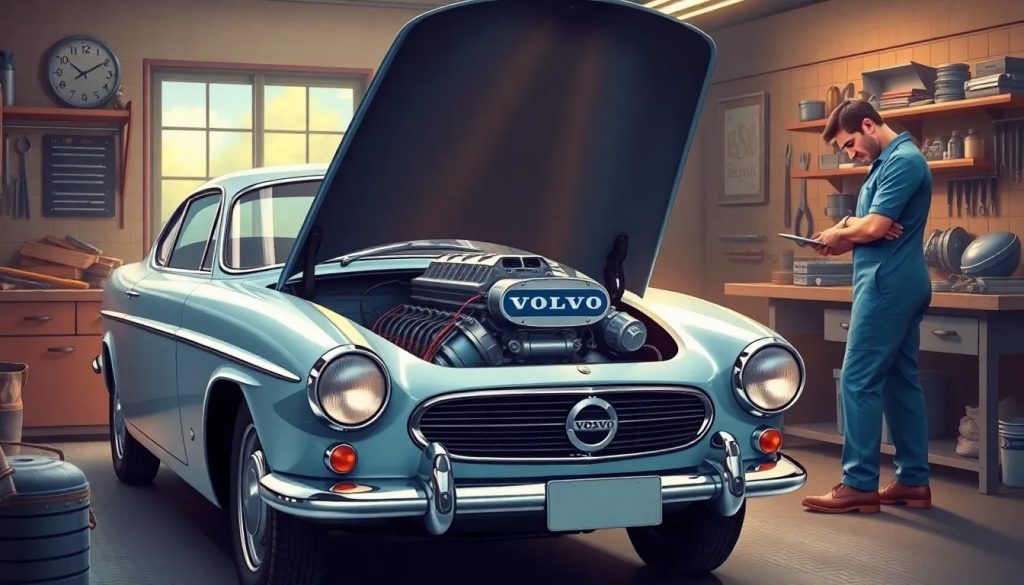Volvo B36 engine specs

The Volvo B36 is a notable V8 engine that has left a significant impact in the realm of commercial vehicles. Engineered by Volvo and introduced in the early 1950s, this engine reflects the innovative spirit of its time and the technical prowess of the company. In this article, we will explore the intricate details of the Volvo B36 engine, its specifications, and its legacy.
- What are the specifications of the Volvo B36 engine?
- How did the Volvo B36 evolve over the years?
- What is the historical significance of the Volvo B36 engine?
- How does the Volvo B36 compare to other Volvo engines?
- What are the main applications of the Volvo B36 engine?
- What innovations did the Volvo B36 engine introduce?
- What is the legacy of the Volvo B36 engine in trucking history?
- Related questions about the Volvo B36 engine
What are the specifications of the Volvo B36 engine?
The Volvo B36 engine specs reveal a robust and well-engineered power unit. This petrol V8 engine features a displacement of 3.56 liters, designed with a cast iron block. It produces 120 horsepower at 4000 RPM, with a torque output of 192 lb-ft at 2200 RPM. The engine architecture is characterized by a 90° bank angle, which it shares with the Volvo B18 engine, showcasing a blend of shared components and unique features.
- Displacement: 3.56 liters
- Configuration: V8
- Power: 120 hp at 4000 RPM
- Torque: 192 lb-ft at 2200 RPM
- Weight: 235 kg
The B36 was initially developed for a luxury car project that never materialized, leading to its eventual adaptations for truck and marine applications. This versatility underlines the B36's importance in Volvo's engine lineup.
How did the Volvo B36 evolve over the years?
Since its introduction in 1952, the Volvo B36 underwent various modifications to enhance its performance and reliability. Initially, this engine was aimed at luxury vehicles but soon found its way into the commercial sector, particularly in trucks. The transition into truck applications marked a turning point in its evolution.
Over the years, the B36's design was refined, focusing on improving fuel efficiency and durability. These enhancements allowed the engine to maintain its relevance even as newer models emerged. The B36 continued to be utilized in different configurations, further solidifying its status within Volvo's engine family.
Additionally, the B36 was part of Volvo's broader strategy to innovate in engine technology. This engine represented a significant step towards developing heavy-duty engines that could meet the growing demands of the trucking industry.
What is the historical significance of the Volvo B36 engine?
The Volvo B36 engine holds a unique place in automotive history, particularly in the context of commercial vehicles. Introduced during a period of technological advancement, it was among the first V8 engines developed for trucks, showcasing Volvo's commitment to innovation.
This engine not only highlighted Volvo's engineering capabilities but also served as a precursor to future developments in heavy-duty engine technology. The B36 was significant in demonstrating the potential of petrol engines in an era where diesel was becoming increasingly popular in commercial applications.
Moreover, the historical context of the B36 is tied to the evolution of the trucking industry. As demands for power and efficiency grew, engines like the B36 paved the way for subsequent innovations that shaped modern heavy-duty vehicles. Its discontinuation in 1973 marked the end of an era, as it was the last petrol truck engine produced by Volvo.
How does the Volvo B36 compare to other Volvo engines?
When comparing the Volvo B36 engine specs to other Volvo engines, several factors come into play, including power output, design, and intended applications. The B36, with its 120 hp and 192 lb-ft of torque, showcases a balance between performance and efficiency that was characteristic of its time.
In contrast, engines like the Volvo B18 were designed primarily for passenger cars, emphasizing a different set of performance metrics. The B36's unique V8 configuration allowed it to produce more torque, making it more suitable for heavy-duty applications than its inline counterparts.
Another point of comparison lies in the evolution of engine technology. While the B36 set a precedent with its V8 architecture, later Volvo engines incorporated advancements such as turbocharging and improved fuel efficiency. This evolution reflects Volvo's ongoing commitment to innovation in engine design.
What are the main applications of the Volvo B36 engine?
The versatility of the Volvo B36 engine is evident in its various applications, particularly in the trucking and marine sectors. Originally intended for luxury vehicles, the engine found its primary use in heavy-duty trucks, where its power and torque were highly valued.
- Heavy-duty trucks
- Marine applications
- Commercial vehicles
- Specialty vehicles
In trucking, the B36 engine provided the necessary power for transporting goods, enabling trucks to operate efficiently under demanding conditions. Its robust design allowed it to withstand the rigors of long hauls and heavy loads, making it a reliable choice for fleet operators.
Additionally, the B36 was adapted for marine applications, where its performance characteristics were similarly beneficial. These diverse uses illustrate the engine's adaptability and significance in various industries.
What innovations did the Volvo B36 engine introduce?
The Volvo B36 engine introduced several innovations that contributed to its reputation in the automotive industry. One of the key innovations was its cast iron construction, which offered durability and heat resistance, essential for heavy-duty applications.
Moreover, the engine's 90° V8 configuration allowed for smoother operation and increased efficiency compared to inline engines. This design facilitated better torque delivery, particularly important in truck applications where power is crucial.
Additionally, the Volvo B36 featured advancements in engine architecture that would influence future designs. Its engineering principles laid the groundwork for the development of more advanced heavy-duty engines, contributing to Volvo's long-standing legacy of innovation.
What is the legacy of the Volvo B36 engine in trucking history?
The legacy of the Volvo B36 engine is profound, cementing its place in trucking history. As the last petrol engine produced by Volvo for trucks, it symbolizes a transitional phase in the automotive industry, where diesel engines began to dominate the market.
Despite its discontinuation in 1973, the B36 remains a significant reference point for enthusiasts and historians alike. Its role in shaping the design and performance standards of commercial engines cannot be overstated.
The B36's influence can still be seen in modern Volvo engines, which continue to emphasize performance, reliability, and efficiency. The innovations it introduced have paved the way for future advancements, highlighting the B36's lasting impact on the trucking industry.
What is the spec of the B36 engine?
The specifications of the B36 engine are impressive for its time, featuring a 3.56-liter V8 design. It produces 120 horsepower at 4000 RPM and 192 lb-ft of torque at 2200 RPM. This engine was engineered for reliability and performance, making it a significant player in the heavy-duty market. Additionally, its construction from durable cast iron ensured it could withstand the rigors of daily use.
The B36's design also facilitated smoother operation, an essential feature for long-haul trucking. The engine’s configuration allowed it to deliver power effectively, which contributed to its success in commercial applications.
What are the Volvo B engines?
The Volvo B engines refer to a family of engines produced by Volvo, designed for various applications, including passenger cars, trucks, and other commercial vehicles. This family includes notable models like the B18 and B36, each characterized by distinct specifications and intended use. The B engines are known for their reliability and engineering quality, allowing Volvo to establish a strong presence in the automotive market.
These engines have evolved over time, adapting to changing technology and market demands. While the B36 was significant as a petrol V8 for trucks, other B engines have introduced innovations like turbocharging and diesel configurations, further enhancing Volvo's reputation for performance and efficiency.
What is the legendary Volvo engine?
When discussing legendary Volvo engines, the B36 often comes to mind due to its unique specifications and historical significance. However, Volvo has produced several noteworthy engines throughout its history, including the B18 and more modern diesel variants. Each of these engines has contributed to Volvo's reputation for engineering excellence and durability.
The B36 stands out as a testament to Volvo's innovative spirit in the 1950s, showcasing a pioneering approach to engine design. Its legacy continues to influence modern engine development within the company and the industry as a whole.
When did Volvo stop making 6 cylinder engines?
Volvo ceased production of six-cylinder engines in the early 1990s, marking a significant shift in their engine lineup. This decision was part of a broader trend towards downsizing engines and increasing efficiency, aligning with changing market demands and environmental standards.
The transition away from six-cylinder engines reflected Volvo's commitment to innovation and adaptability. Although the B36 and other six-cylinder models played a crucial role in the company's history, the evolution of engine technology has led to a focus on more efficient configurations, including four-cylinder engines with turbocharging capabilities.
 Volvo D36 engine specs
Volvo D36 engine specs Volvo D39 engine specs
Volvo D39 engine specs Volvo D39 specifications and features
Volvo D39 specifications and features Volvo D11 engine overview
Volvo D11 engine overviewIf you want to know other articles similar to Volvo B36 engine specs you can visit the category VOLVO.
Leave a Reply

RELATED POSTS